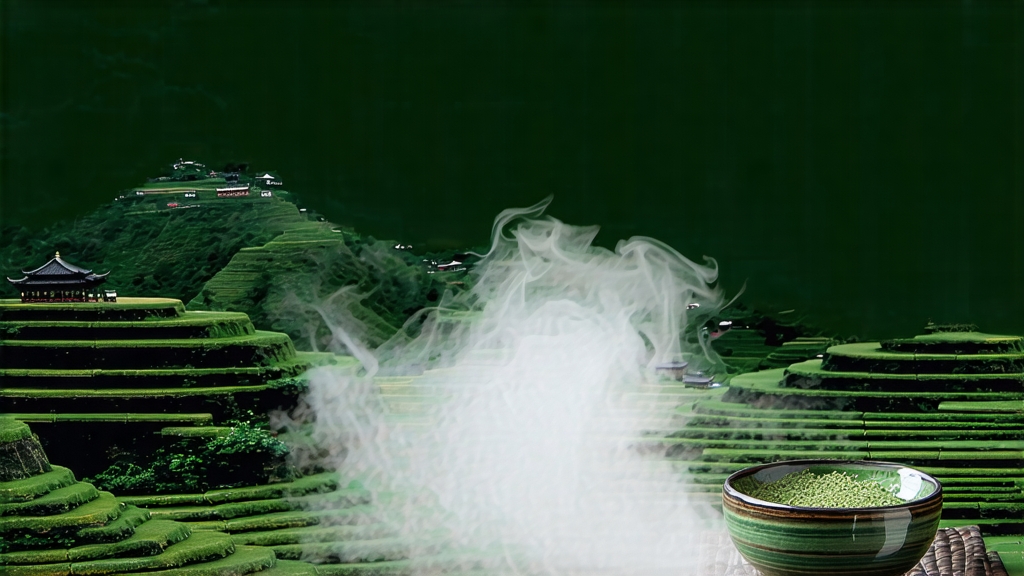
Tucked high on the mist-laden shoulders of Mt. Mengding in Sichuan province, a tea once reserved for emperors still awakens each spring under a veil of clouds. Mengding Huangya—literally “Yellow Bud from Mengding”—is the oldest documented yellow tea, its pedigree traceable to the Tang dynasty (618-907 CE) when it was pressed into cakes and carried along the Silk Road as tribute. Unlike the better-known green teas of neighboring hills, Mengding Huangya undergoes a secretive “sealed yellowing” that turns the leaf a pale champagne and softens its qi into something both regal and mellow. For the international drinker accustomed to the bright snap of Longjing or the muscatel of Darjeeling, this yellow bud offers a quiet, velvety revelation: a liquor that glows like morning light on bamboo and finishes with the sweetness of steamed corn milk.
History: from tribute to near oblivion
Mengding mountain has been cultivated for tea since 53 BCE when the Daoist Wu Lizhen planted seven bushes that were later declared “celestial.” During the Tang court, the monk Shi Xing prepared a yellowed version of the local bud tea for Emperor Xuanzong; its golden color was deemed auspicious, symbolizing the dragon throne itself. Song dynasty records describe “gold leaf tea” wrapped in yellow silk and escorted by mounted guards to Kaifeng. By the Ming, loose-leaf fashion eclipsed compressed cakes, yet Mengding Huangya survived in tiny lots for Qing emperors who prized its gentle stimulation. The 20th century brought war and market neglect; the craft was nearly lost until 1959 when a state restoration project located three aged artisans who still remembered the slow yellowing ritual. Today only 300 mu (20 hectares) of heritage gardens at 1,200–1,400 m are authorized to bear the name, yielding barely six tons a year—rarer than top-grade Da Hong Pao.
Micro-terroir: where cloud kisses granite
Mt. Mengding sits at the junction of the Tibetan Plateau’s downdrafts and the Sichuan Basin’s warm humidity. Spring mornings begin at 10 °C, rising to 22 °C by noon; the 80 % relative humidity lengthens withering time and encourages a microbial flora unique to the bamboo sheds. The soil is Phyllite-derived, slightly acidic (pH 5.2), and laced with selenium leached from granite seams. Such chemistry lowers catechin bitterness and boosts theanine, giving the tea its signature umami custard note. Gardens are interplanted with ginkgo and wild orchid; their fallen leaves add a faint orchid-ginkgo imprint that later surfaces in the cup.
Pluck standard: one bud, no leaf, before Qingming
Harvest opens on the first insect-sung dawn after March 20, when the bud reaches 15–20 mm but has not yet unfurled into a leaf. Experienced pickers use thumbnail, not fingertip, to avoid bruising; the pluck must include the white down tip and a barely visible “red line” at the base—an indicator of optimal enzymatic balance. A full kilo of finished tea requires 42,000 buds, roughly three hours of focused picking by a swift-handed grandmother.
Craft: the art of “men huang” (sealed yellowing)
Although yellow tea is often described as “green tea with an extra step,” the reality is more alchemical. Mengding Huangya follows a five-stage rhythm that can stretch across four days:
- Sha Qing (Kill-green): 160 °C bamboo roaster for 90 seconds. The goal is to halt oxidation yet keep 8–10 % residual enzyme activity—higher than green tea—essential for later yellowing.
- Re-wrap Rest: the semi-hot leaf is immediately piled 3 cm deep in linen bags and rested 30 minutes; internal temperature hovers at 45 °C, initiating non-enzymatic browning.
- Chu Bao (First yellowing): buds are spread in dark bamboo trays 1 cm thick, covered with wet calico, and kept at 32 °C and 85 % humidity for 24 hours. A faint yellow tinge appears; volatile coumarins develop, lending a toasted rice aroma.
- Fu Bao (Second yellow